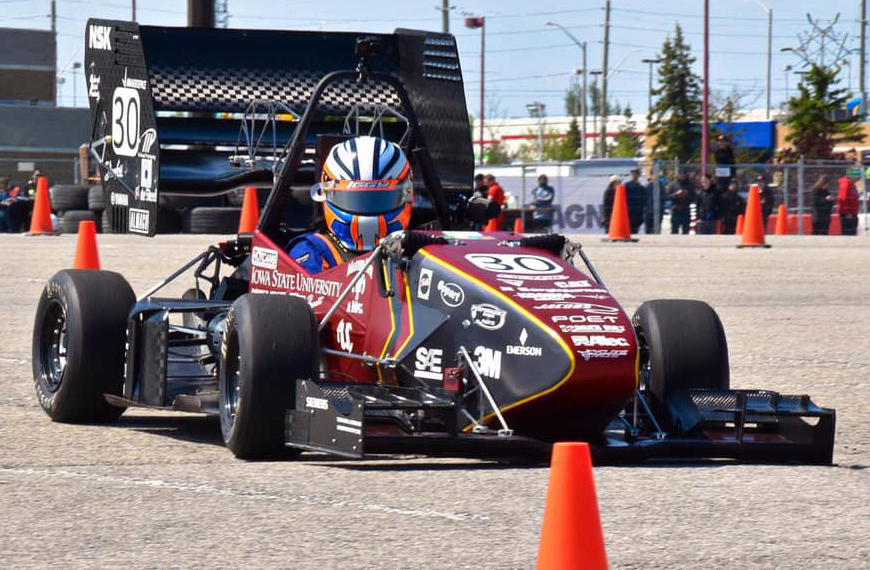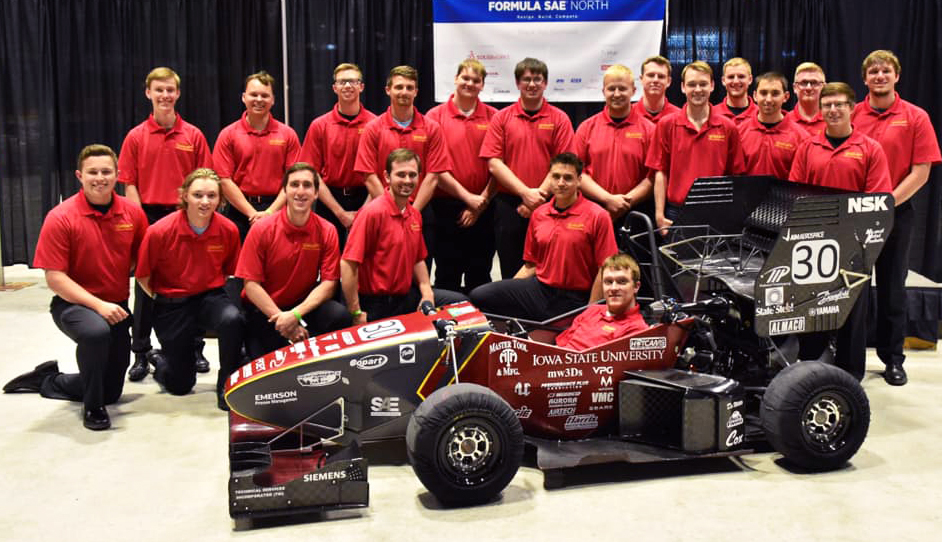
Iowa State's Formula SAE team raced to an eighth-place overall finish at this year's competition in Canada. Larger photo. Photo courtesy of Iowa State's Formula SAE team.
AMES, Iowa – It was a hot, sunny, Saturday afternoon and Iowa State's Formula SAE shop was full of student-engineers.
Somehow, some way, they wanted to trim a few tenths of a second from their best skidpad time when they head to the Formula SAE competition in Lincoln, Nebraska, June 19-22. So they found an empty parking lot and did some testing.
They wanted to give their inexperienced drivers some more time at speed over the tight figure-eight course. They considered a more forgiving suspension setup to help the drivers handle the car. They worked to improve braking performance. They tuned the differential to minimize tire spin. And they collected track data to validate their computer models.
"This car is fast," said Grant Fidler, a senior in mechanical engineering from West Des Moines, the team's power train leader and one of the drivers. "The car is well engineered and built, we just need to get the driver confidence to push it to its limits and get fast times."
Another driver – John Kremer, a December graduate in aerospace engineering from Sussex, Wisconsin – said fractions of a second faster could make a difference.
"Dropping those three 10ths would put us at the top," he said.
The team has already passed its first major track test, ranking eighth of 22 scored teams at the recent Formula SAE North competition in Barrie, Ontario, Canada. Formula North and other competitions sponsored by SAE International (formerly the Society of Automotive Engineers) give students around the world the chance to design and build formula-style, single-seat, open-wheel race cars.
Up in Canada, the team finished second in aerodynamic design, fourth in fuel efficiency, tied for sixth in overall design and seventh in the big event, the 13-mile endurance race worth more than a fourth of the contest's possible points.
So what can team members tell us about that high-scoring aerodynamic design?
Jimmy Roslansky, a senior in aerospace engineering from Minnetonka, Minnesota, and the team's aerodynamics leader, is especially proud of the car's front wings. They're a wonder of flicks and tuning vanes directing air around the car's wheels, all in the name of reducing drag and increasing top speeds.
Bruce Ciccotosto, a junior from Ingleside, Illinois, who's majoring in aerospace engineering, said the front wing is also tougher because it's now made of a hybrid carbon-Kevlar weave.
Then there's the huge, multi-element rear wing. Just like the big-dollar racing cars in Formula 1, the rear wing includes a driver-activated drag reduction system. The driver pushes a button on the steering wheel and one of the rear wing elements flattens, reducing drag by about 60 pounds and increasing straight-line speed.
So, there was optimism in the formula garage on a summer Saturday. Team members think they can find some extra speed.
Where will they look?
They'll do what engineers do – analyze the data, said Peter Chiodo, a May graduate in mechanical engineering from Streamwood, Illinois, and another driver.
"We've put a major emphasis," he said, "on obtaining and validating that data."
-----

Iowa State's Formula SAE racers at a recent competition in Canada. Larger photo. Photo courtesy of Iowa State's Formula SAE team.






